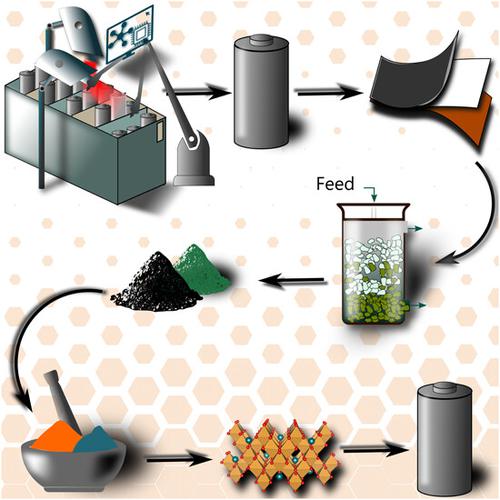当前位置:
X-MOL 学术
›
Carbon Energy
›
论文详情
Our official English website, www.x-mol.net, welcomes your feedback! (Note: you will need to create a separate account there.)
Direct recycling of Li-ion batteries from cell to pack level: Challenges and prospects on technology, scalability, sustainability, and economics
Carbon Energy ( IF 20.5 ) Pub Date : 2024-02-29 , DOI: 10.1002/cey2.492 Joseph Jegan Roy 1, 2 , Do Minh Phuong 1, 2 , Vivek Verma 1, 2 , Richa Chaudhary 1, 2 , Michael Carboni 3 , Daniel Meyer 3 , Bin Cao 4 , Madhavi Srinivasan 1, 2
Carbon Energy ( IF 20.5 ) Pub Date : 2024-02-29 , DOI: 10.1002/cey2.492 Joseph Jegan Roy 1, 2 , Do Minh Phuong 1, 2 , Vivek Verma 1, 2 , Richa Chaudhary 1, 2 , Michael Carboni 3 , Daniel Meyer 3 , Bin Cao 4 , Madhavi Srinivasan 1, 2
Affiliation

|
Direct recycling is a novel approach to overcoming the drawbacks of conventional lithium-ion battery (LIB) recycling processes and has gained considerable attention from the academic and industrial sectors in recent years. The primary objective of directly recycling LIBs is to efficiently recover and restore the active electrode materials and other components in the solid phase while retaining electrochemical performance. This technology's advantages over traditional pyrometallurgy and hydrometallurgy are cost-effectiveness, energy efficiency, and sustainability, and it preserves the material structure and morphology and can shorten the overall recycling path. This review extensively discusses the advancements in the direct recycling of LIBs, including battery sorting, pretreatment processes, separation of cathode and anode materials, and regeneration and quality enhancement of electrode materials. It encompasses various approaches to successfully regenerate high-value electrode materials and streamlining the recovery process without compromising their electrochemical properties. Furthermore, we highlight key challenges in direct recycling when scaled from lab to industries in four perspectives: (1) battery design, (2) disassembling, (3) electrode delamination, and (4) commercialization and sustainability. Based on these challenges and changing market trends, a few strategies are discussed to aid direct recycling efforts, such as binders, electrolyte selection, and alternative battery designs; and recent transitions and technological advancements in the battery industry are presented.
中文翻译:

锂离子电池从电芯到电池组的直接回收:技术、可扩展性、可持续性和经济性方面的挑战和前景
直接回收是克服传统锂离子电池(LIB)回收工艺缺点的一种新方法,近年来受到学术界和工业界的广泛关注。直接回收锂离子电池的主要目标是有效回收和恢复固相中的活性电极材料和其他成分,同时保持电化学性能。与传统火法冶金和湿法冶金相比,该技术的优势在于成本效益、能源效率和可持续性,并且保留了材料的结构和形态,可以缩短整体回收路径。这篇综述广泛讨论了锂离子电池直接回收的进展,包括电池分类、预处理工艺、正极和负极材料的分离以及电极材料的再生和质量提高。它涵盖了成功再生高价值电极材料并简化回收过程而不影响其电化学性能的各种方法。此外,我们从四个角度强调了直接回收从实验室扩展到工业时的关键挑战:(1)电池设计,(2)拆卸,(3)电极分层,以及(4)商业化和可持续性。基于这些挑战和不断变化的市场趋势,讨论了一些有助于直接回收工作的策略,例如粘合剂、电解质选择和替代电池设计;并介绍了电池行业的最新转变和技术进步。
更新日期:2024-03-01
中文翻译:

锂离子电池从电芯到电池组的直接回收:技术、可扩展性、可持续性和经济性方面的挑战和前景
直接回收是克服传统锂离子电池(LIB)回收工艺缺点的一种新方法,近年来受到学术界和工业界的广泛关注。直接回收锂离子电池的主要目标是有效回收和恢复固相中的活性电极材料和其他成分,同时保持电化学性能。与传统火法冶金和湿法冶金相比,该技术的优势在于成本效益、能源效率和可持续性,并且保留了材料的结构和形态,可以缩短整体回收路径。这篇综述广泛讨论了锂离子电池直接回收的进展,包括电池分类、预处理工艺、正极和负极材料的分离以及电极材料的再生和质量提高。它涵盖了成功再生高价值电极材料并简化回收过程而不影响其电化学性能的各种方法。此外,我们从四个角度强调了直接回收从实验室扩展到工业时的关键挑战:(1)电池设计,(2)拆卸,(3)电极分层,以及(4)商业化和可持续性。基于这些挑战和不断变化的市场趋势,讨论了一些有助于直接回收工作的策略,例如粘合剂、电解质选择和替代电池设计;并介绍了电池行业的最新转变和技术进步。



























 京公网安备 11010802027423号
京公网安备 11010802027423号